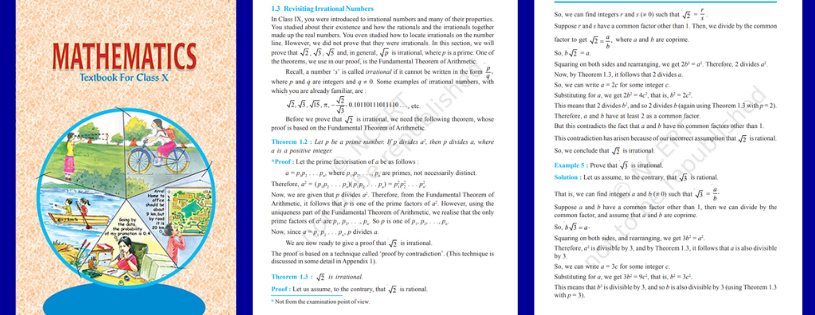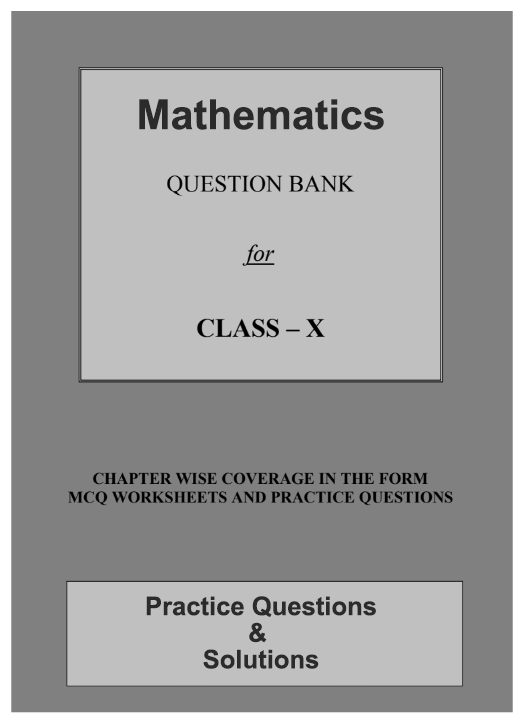Welcome to the world of mathematics, where every chapter unfolds a new realm of understanding. In this blog post, we embark on a journey through CBSE NCERT Class 10, Chapter 1, exploring the intriguing topic of Revisiting Irrational Numbers.
Unlocking Mathematical Wonders: CBSE Class 10 NCERT Mathematics Revisiting Irrational Numbers for a Deeper Understanding

An irrational number is a real number that cannot be expressed as a ratio of integers; for example, √2 is an irrational number. We cannot express any irrational number in the form of a ratio, such as p/q, where p and q are integers, q≠0.A number x is said to be an irrational number if it cannot be expressed in the form of pq where q≠0.
As we delve into the depths of this chapter, we'll not only grasp the fundamentals but also discover the significance of revisiting these fascinating mathematical entities.
Understanding the Basics
Before we dive into the specifics of irrational numbers, let's take a moment to refresh our memory on the foundations of mathematics. In Class 10, the NCERT curriculum provides a comprehensive guide to various mathematical concepts, and Chapter 1 lays the groundwork for our exploration.
Revisiting Irrational Numbers

The term "irrational numbers" might sound complex, but fear not! This chapter aims to demystify the concept and shed light on its importance in the world of mathematics. We'll explore the characteristics of irrational numbers, their properties, and real-world applications.
Summary
Embark on a mathematical odyssey with our exploration of CBSE NCERT Class 10, Chapter 1 – Real Numbers. This chapter serves as a gateway to understanding the fundamental concepts that underpin the entire mathematical landscape.
Key Takeaways
Definition of Irrational Numbers: Understand the definition of irrational numbers and how they differ from rational numbers
-
Examples that showcase the irrationality of certain numbers.
Properties of Irrational Numbers: Delve into the unique properties of irrational numbers, such as non-terminating and non-repeating decimals.
-
Learn how to identify irrational numbers in various forms.
Real-World Applications: Uncover the practical applications of irrational numbers in fields like geometry, physics, and more.
-
Appreciate how these numbers play a crucial role in describing natural phenomena.
Decoding the World of Numbers: A Journey through CBSE NCERT Class 10, Chapter 1 – Real Numbers
In "Real Numbers," we unravel the essence of the numerical realm, delving into the distinctions between rational and irrational numbers. The chapter introduces students to the concept of Euclid's Division Lemma and the Fundamental Theorem of Arithmetic, providing a solid foundation for more advanced mathematical principles.
Key highlights of the chapter include
Rational and Irrational Numbers: A comprehensive breakdown of rational and irrational numbers, offering clarity on their definitions and distinctions.
Euclid's Division Lemma: An in-depth exploration of Euclid's Division Lemma, revealing its significance in the division of integers and paving the way for a deeper understanding of mathematical algorithms.
Fundamental Theorem of Arithmetic: Unveiling the elegance of the Fundamental Theorem of Arithmetic, showcasing how every positive integer can be expressed uniquely as a product of prime numbers.
As students navigate through the intricacies of "Real Numbers," they gain not only a conceptual understanding of the material but also a toolkit for solving real-world mathematical problems. The chapter lays the groundwork for subsequent topics, setting the stage for a holistic mathematical education.
CBSE Class 10th Downloadable Resources:
| 1. CBSE Class 10th Topic Wise Summary | View Page / Download |
| 2. CBSE Class 10th NCERT Books | View Page / Download |
| 3. CBSE Class 10th NCERT Solutions | View Page / Download |
| 4. CBSE Class 10th Exemplar | View Page / Download |
| 5. CBSE Class 10th Previous Year Papers | View Page / Download |
| 6. CBSE Class 10th Sample Papers | View Page / Download |
| 7. CBSE Class 10th Question Bank | View Page / Download |
| 8. CBSE Class 10th Topic Wise Revision Notes | View Page / Download |
| 9. CBSE Class 10th Last Minutes Preparation Resources (LMP) | View Page / Download |
| 10. CBSE Class 10th Best Reference Books | View Page / Download |
| 11. CBSE Class 10th Formula Booklet | View Page / Download |
Being in CBSE class 10th and considering the board examinations you must be needing resources to excel in your examinations. At TestprepKart we take great pride in providing CBSE class 10th all study resources in downloadable form for you to keep you going.
Below is the list of all CBSE class 10th Downloads available on TestprepKart for both Indian and NRI students preparing for CBSE class 10th in UAE, Oman, Qatar, Kuwait & Bahrain.
SAMPLE PRACTICE QUESTION RATIONAL NUMBERS
Q1: What defines a number as irrational?
Ans: An irrational number cannot be expressed as a fraction of two integers, and its decimal representation goes on forever without repeating.
Q2: Can you provide an example of a well-known irrational number?
Ans: Certainly! The square root of 2 (\(\sqrt{2}\)) is a classic example of an irrational number.
Q3: How do irrational numbers differ from rational numbers in terms of representation?
Ans: Rational numbers can be expressed as fractions, while irrational numbers require infinite, non-repeating decimals or other non-terminating representations.
Q4: Is \(\pi\) an irrational number?
Ans: Yes, \(\pi\) (pi) is an irrational number. Its decimal representation extends infinitely without repeating.
Q5: What role do irrational numbers play in geometry?
Ans: Irrational numbers, like \(\sqrt{2}\) and \(\pi\), appear in geometric calculations and constructions, challenging the idea that all lengths are rational.

Leave a Reply